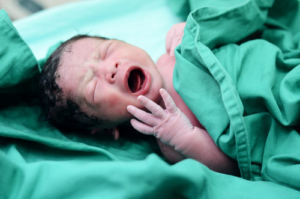 If a baby suffers a traumatic birth or has complications in the neonatal intensive care unit (NICU), he or she may suffer hypoxic ischemic encephalopathy (HIE). HIE is caused by the inadequate distribution of oxygen and limited blood flow to the baby’s brain at the time of birth or shortly thereafter. This serious problem can damage the central nervous system, causing cerebral palsy, brain damage, and even death. Newborn cooling therapy, also known as hypothermia treatment, is a relatively new treatment for HIE. While cooling therapy has had success, the method also comes with risks.
If a baby suffers a traumatic birth or has complications in the neonatal intensive care unit (NICU), he or she may suffer hypoxic ischemic encephalopathy (HIE). HIE is caused by the inadequate distribution of oxygen and limited blood flow to the baby’s brain at the time of birth or shortly thereafter. This serious problem can damage the central nervous system, causing cerebral palsy, brain damage, and even death. Newborn cooling therapy, also known as hypothermia treatment, is a relatively new treatment for HIE. While cooling therapy has had success, the method also comes with risks.
1. Cooling therapy must happen almost immediately.
Neonatal therapeutic hypothermia lowers an infant’s total body temperature but the treatment must be undertaken within hours after birth since brain cells begin to die within minutes of oxygen deprivation. The goal is to allow the cooling to slow down the damage that began to occur when the brain was deprived of oxygen, ideally decreasing the severity of permanent brain damage.
Sometimes, however, birth injury and oxygen deprivation are not or cannot be promptly diagnosed, which means the chance to benefit from newborn cooling therapy is eliminated.
2. Yes, the baby is placed in a cold environment.
The methodology of cooling therapy is to place the infant in a clinical setting with a temperature of around 91 degrees Fahrenheit. This usually happens through a cooling cap or cooling blanket intended to drop the baby’s body temperature. Hypothermia treatment usually takes place over 72 hours during which time the baby is carefully monitored.
By decreasing the infant’s body temperature, its metabolic rate is slowed, allowing damaged cells to recover from trauma. This treatment can prevent the spreading, severity, and permanence of brain damage in babies who have suffered a birth injury.
3. Babies exhibit signs that hypothermia treating may be needed.
If a baby has suffered hypoxic ischemic encephalopathy, he or she is likely to exhibit signs of encephalopathy such as:
- Fetal heart abnormalities.
- Difficult delivery.
- Delayed C-section.
- Umbilical cord problems.
- Lack of oxygen in the mother’s blood.
- Low APGAR score.
- Need for resuscitation and oxygen.
- Abnormal brain functions.
To receive hypothermia treatment, babies must be born at 34 to 36 weeks or later. Cooling therapy is not indicated for premature babies or those with low birth weight, intracranial hemorrhage, congenital abnormalities, and septicemia.
4. There are many ways newborn cooling therapy could go wrong.
As with any medical treatment, there are risks to cooling therapy. Most medical experts who support the treatment, however, believe the benefits outweigh the risks, which can include slightly increased heart rate in infants, the need for blood pressure support, and blood clotting.
In some cases, it is not necessarily the cooling therapy treatment itself that can harm the baby. Perhaps cooling therapy could have been helpful to an infant and reduced the severity of brain damage, but a quick and accurate HIE diagnosis was overlooked or the infant was misdiagnosed. Perhaps a child should have never suffered a brain injury at all or needed hypothermia treatment, but the negligence of the doctor, nurses, or other medical staff led to the traumatic birth injury.
Get Legal Help After Your Child’s Birth Injury
Newborn cooling therapy is a new treatment, and while it has been proven beneficial for many infants, the treatment is doubted by many. If your child has suffered a birth injury and oxygen deprivation like hypoxic ischemic encephalopathy, contact the birth injury lawyers at Thurswell Law to schedule a free consultation to discuss your case. We do not charge any fees unless you collect. Call (248) 354-2222 today.







